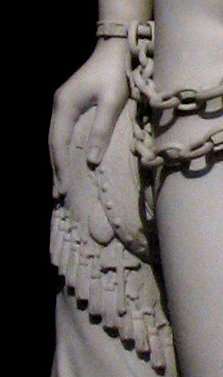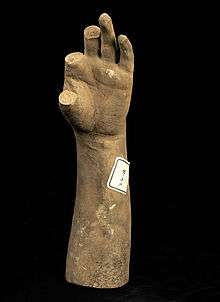The Greek Slave
The Greek Slave is a marble sculpture by the American sculptor Hiram Powers. It was one of the best-known and critically acclaimed American artworks of the nineteenth century,[1] and is among the most popular American sculptures ever.[2] It was the first publicly exhibited, life-size, American sculpture depicting a fully nude female figure. Powers originally modeled the work in clay, in Florence, Italy, completing it on March 12, 1843.[3][4] The first marble version (prime version) of the sculpture was completed by Powers' studio in 1844 and is now in Raby Castle, England.[2]
| The Greek Slave | |
|---|---|
 At Yale University Art Gallery | |
| Artist | Hiram Powers |
| Year | model completed 1843; marbles 1844–1860s |
| Type | marble sculpture |
| Dimensions | 165.7 cm × 53.3 cm × 46.4 cm (65.2 in × 21.0 in × 18.3 in) |
| Weight | c. 236 kilograms (520 lb) |
| Location |
|
Five more full-sized versions of the statue in marble were mechanically reproduced for private patrons, based on Powers' original model, along with numerous smaller-scale versions. Copies of the statue were displayed in a number of venues around Great Britain and the United States; it quickly became one of Powers' most famous works, and held symbolic meaning for some American abolitionists, inspiring an outpouring of prose and poetry.[5] The position of the figure is said to have been inspired by the Venus de' Medici in the Uffizi Gallery in Florence.[6]
Subject
The statue depicts a young woman, nude, bound in chains; in one hand she holds a small cross on a chain. Powers himself described the subject of the work thus:
The Slave has been taken from one of the Greek Islands by the Turks, in the time of the Greek revolution, the history of which is familiar to all. Her father and mother, and perhaps all her kindred, have been destroyed by her foes, and she alone preserved as a treasure too valuable to be thrown away. She is now among barbarian strangers, under the pressure of a full recollection of the calamitous events which have brought her to her present state; and she stands exposed to the gaze of the people she abhors, and awaits her fate with intense anxiety, tempered indeed by the support of her reliance upon the goodness of God. Gather all these afflictions together, and add to them the fortitude and resignation of a Christian, and no room will be left for shame.[7]


When the statue was taken on tour in 1847 and 1848, Miner Kellogg, a friend of the artist and manager of the tour put together a pamphlet to hand out to exhibition visitors. He provided his own description of the piece:
The ostensible subject is merely a Grecian maiden, made captive by the Turks and exposed at Istanbul, for sale. The cross and locket, visible amid the drapery, indicate that she is a Christian, and beloved. But this simple phase by no means completes the meaning of the statue. It represents a being superior to suffering, and raised above degradation, by inward purity and force of character. Thus the Greek Slave is an emblem of the trial to which all humanity is subject, and may be regarded as a type of resignation, uncompromising virtue, or sublime patience.[7]
Public reaction

Public reaction to the statue was mixed. When the work was first exhibited, many people were scandalized by the figure's nudity; Powers countered much of this criticism by suggesting that the young woman was a perfect example of Christian purity and chastity, because even in her unclothed state she was attempting to shield herself from the gaze of onlookers. Furthermore, he said, her nudity was no fault of her own, but rather was caused by her Turkish captors, who stripped her to display her for sale. So well did this reasoning work that many Christian pastors would exhort their congregations to go and see the statue when it was displayed.[6]
Some viewers also drew parallels between The Greek Slave and the slaves who were concurrently working on the plantations of the American South. Such parallels were initially lost upon much of the statue's American audience, but as the American Civil War neared, abolitionists began to take the piece as a symbol, and to compare it with "the Virginian Slave".[7] The comparison was the subject of a poem by John Greenleaf Whittier. The statue also inspired a sonnet by Elizabeth Barrett Browning called "Hiram Powers' Greek Slave". Abolitionist Maria White Lowell wrote that The Greek Slave "was a vision of beauty that one must always look back to the first time of seeing it as an era".[8] In 1848, while walking through Boston Common, Lucy Stone stopped to admire the statue and broke into tears, seeing in its chains the symbol of man's oppression of the female sex. From that day forward, Stone included women's rights issues in her speeches.[9]
Fabrication technique
Powers conceived of the Greek Slave as an artwork that would be produced in one or more finished marble statues, a common practice in nineteenth-century sculpture studios. He and his contemporaries rarely carved the final marble products themselves, relying instead on teams of skilled artisans to produce the finished works on their behalf. After he completed a full-scale clay model of the sculpture in his studio in Florence, Powers gave the model over to professional plaster casters. The casters created a multi-part plaster mold, which was used in turn to cast a durable plaster version of the sculpture.[10][11] Metal armatures inside the form provided support; these can now be seen in modern x-ray images.
Master carvers then used the durable plaster cast as a measuring tool, covering the surface of the plaster cast with hundreds of pencil marks and metal pins, or points, which served as registration marks for a pointing machine. The pointing machine was moved repeatedly from the points on the plaster cast to corresponding areas on a block of marble to guide the carver's tools as he translated the composition into marble.[10] The tool would then be moved, over and over again, hundreds of times, from the points on the plaster to the corresponding locations on the block of marble. Each time, the tool would measure the depth and location on the marble block, creating a three-dimensional guide that helped the marble carver replicate the artist's original form more quickly and with greater ease.[12] When creating the finished marble versions, fine details such as the cross, locket, and chains were finalised, and differ slightly among the marble versions. The Smithsonian American Art Museum holds the original 1843 pointed-plaster mold, along with numerous smaller casts from Powers' studio.[3]
Versions of the artwork
Powers' studio produced five full-scale marble versions of the Greek Slave. Nearly identical, each one was made for sale to a different private collector. An Englishman purchased the first of the large marble versions (now at Raby Castle), and it was exhibited publicly in London in 1845 at Graves' Pall Mall. In 1851, it was featured by the U.S. at The Great Exhibition in London, and four years later was shown in Paris.[13] The second was purchased by William Wilson Corcoran in 1851, and entered into the collection of the Corcoran Gallery of Art in Washington, D.C.; with the 2014 dispersal of the Corcoran collection, the statue was acquired by the National Gallery of Art.[1][2]
Many smaller marble copies of the statue exist, including a 3⁄4-sized marble in the Smithsonian American Art Museum,[14] as well as versions in the Vermont State House, at the Berkshire Museum in Pittsfield, Massachusetts, and the Westervelt Warner Museum of American Art in Tuscaloosa, Alabama.[15]
The English potters Mintons produced much-reduced (14 1/2 inches high) copies in Parian ware from 1848. From 1849 the chains between the slave's hands were not shown, probably to save costs in production.[16]
In 2004, Vermont Governor James Douglas ordered the removal from his office of a small lamp replicating the artwork, citing fears that schoolchildren might see it.[17]
Locations
Life-size versions
There are six versions: the plaster and five marble statues created from it.[18]
- Smithsonian American Art Museum – the original 1843 plaster model from which the finished marble versions were produced
- Raby Castle, County Durham, England (1844)
- National Gallery of Art, Washington, D.C. (1846)[1]
- Newark Museum, Newark, New Jersey (1847)[19]
- Yale University Art Gallery, New Haven, Connecticut (1850)[5]
- Brooklyn Museum, Brooklyn, New York (1866; the final version)[20]
Smaller-scale versions
- Smithsonian American Art Museum, Washington, D.C. (about 3/4 size).[21]
- Victoria and Albert Museum, London
- Fine Arts Museums of San Francisco, 45 1/2 x 15 x 12 in. (115.6 x 38.1 x 30.5 cm), c. 1873.[22]
Research
In early 2015, the Smithsonian Digitization Program made a three-dimensional scan of the original plaster cast of the sculpture. This scan is now available on their website with an interactive portion, as well as a downloadable version. With this, anyone in possession of a 3D printer can now create their own replica of the piece.[10]
Notes
- "The Greek Slave". Washington, D.C.: National Gallery of Art. Retrieved July 6, 2015.
- "The Greek Slave". The Corcoran. Retrieved May 26, 2018.
- "Plaster model of Hiram Powers' "Greek Slave"". Smithsonian American Art Museum. Retrieved July 6, 2015.
- Taft, Lorado (1903). The History of American Sculpture. Harvard University: Macmillan. p. 61.
- "The Greek Slave". American Paintings and Sculpture. Yale University Art Gallery. Retrieved July 6, 2015.
- "Hiram Powers' 'The Greek Slave'". Assumption College. Retrieved November 20, 2006.
- "Powers' "Greek Slave"". Uncle Tom's Cabin & American Culture. University of Virginia. Retrieved November 20, 2006.
- Wagenknecht, Edward. James Russell Lowell: Portrait of a Many-Sided Man. New York: Oxford University Press, 1971: 138.
- McMillen, Sally Gregory. Seneca Falls and the origins of the women's rights movement. Oxford University Press, 2008, p. 81. ISBN 0-19-518265-0
- Lemmey, Karen (March 6, 2015). "3D Scanning: The 21st-Century Equivalent to a 19th-Century Process". Smithsonian American Art Museum. Retrieved July 6, 2015.
- Lemmey, Karen (2016). "From Skeleton to Skin: The Making of the Greek Slave(s)". Nineteenth-Century Art Worldwide. 15 (2). Retrieved December 29, 2018.
- Rabent, Allison. "Conservation: Cleaning Hiram Powers' Greek Slave". Smithsonian American Art Museum. Retrieved July 6, 2015.
- Hyman, Linda (1976). "The Greek Slave by Hiram Powers: High Art as Popular Culture". Art Journal. College Art Association. 35 (3): 216–223. doi:10.2307/775939. JSTOR 775939.
- "Greek Slave, by Hiram Powers". Smithsonian American Art Museum. Smithsonian Institution. Retrieved July 6, 2015.
- Rawls, Phillip (July 2009). "Alabama ban of wine with nude label is marketing boon". The Boston Globe. Retrieved July 31, 2009.
- "The Greek Slave", Metropolitan
- "Governor Wants Iconic Nude Off His Desk". The New York Times. December 12, 2004.
- Hyman, footnote 3
- "Search Our Collection". Newark Museum. Retrieved May 27, 2018.
- "The Greek Slave". Brooklyn Museum. Retrieved May 27, 2018.
- Wunder, Richard P. (1991). Hiram Powers: Vermont Sculptor, 1805–1873, Vol. 2. Newark, Delaware: University of Delaware Press. pp. 157–168. ISBN 978-0-87413-310-3.
- Fine Arts Museums of San Francisco
Sources
- Lessing, Lauren (Spring 2010). "Ties that Bind: Hiram Powers' Greek Slave and Nineteenth-century Marriage". American Art. 24 (1): 41–65. doi:10.1086/652743. JSTOR 10.1086/652743.
External links
| Wikimedia Commons has media related to The Greek Slave. |
- Measured Perfection: Hiram Powers' Greek Slave – 2015–2017 Smithsonian museum exhibition
- Model of The Greek Slave - Smithsonian American Art Museum
- The Greek Slave - art object page, National Gallery of Art